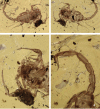A preliminary synopsis on amber scorpions with special reference to Burmite species: an extraordinary development of our knowledge in only 20 years
- PMID: 27408601
- PMCID: PMC4926682
- DOI: 10.3897/zookeys.600.8913
A preliminary synopsis on amber scorpions with special reference to Burmite species: an extraordinary development of our knowledge in only 20 years
Abstract
A preliminary study on fossil scorpions found in amber, from the Lower Cretaceous through the Palaeocene and up to the Miocene is proposed. Scorpions remain rare among the arthropods found trapped in amber. Only 24 specimens are known from Cretaceous amber, representing eight families and subfamilies, ten genera and 21 species; in parallel, 10 specimens have been recorded from Baltic amber representing seven genera and ten species. A few more recent fossils from Dominican and Mexican amber have also been described. The present study of a new scorpion specimen from the Cretaceous amber of Myanmar (Burmite) resulted in the description of one new species, Betaburmesebuthus bellus sp. n. - belonging to the subfamily Palaeoburmesebuthinae Lourenço, 2015. The new description brings further elements to the clarification of the status of this subfamily, which is now raised to family level. Once again, this new Burmite element attests to the considerable degree of diversity in the Burmese amber-producing forests.
Keywords: Burmite; Cretaceous; Myanmar; Palaeoburmesebuthidae; fossil; new species; scorpion.
Figures




References
-
- Baptista CJ, Santiago-Blay JA, Soleglad ME, Fet V. (2006) The Cretaceous scorpion genus, Archaeobuthus, revisited (Scorpiones: Archaeobuthidae). Euscorpius 35: 1–40.
-
- Holl F. (1829) Handbuch der Petrefactenkunde. Hilscher, Dresden.
-
- Kjellesvig-Waering EN. (1986) A restudy of the fossil Scorpionida of the world. Palaeontographica Americana 55: 1–287.
-
- Larsson SG. (1978) Baltic Amber – a Palaeobiological Study. Entomonograph 1. Scandinavian Science Press Ltd., Klampenborg, Denmark.
-
- Lourenço WR. (2001) A remarkable scorpion fossil from the amber of Lebanon. Implications for the phylogeny of Buthoidea. Comptes Rendus de l’Académie des Sciences, Paris 332: 641–646. doi: 10.1016/s1251-8050(01)01583-x - DOI
LinkOut - more resources
Full Text Sources
Other Literature Sources
